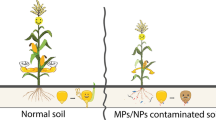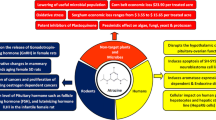Abstract
Purpose
Plants can absorb a diversity of natural and man-made toxic compounds for which they have developed diverse detoxification mechanisms. Plants are able to metabolize and detoxify a wide array of xenobiotics by oxidation, sugar conjugation, glutathione conjugation, and more complex reactions. In this study, detoxification mechanisms of dimethomorph, a fungicide currently found in aquatic media were investigated in Elodea canadensis.
Methods
Cytochrome P450 (P450) activity was measured by an oxygen biosensor system, glucosyltransferases (GTs) by HPLC, glutathione S-transferases (GSTs), and ascorbate peroxidase (APOX) were assayed spectrophotometrically.
Results
Incubation of Elodea with dimethomorph induced an increase of the P450 activity. GST activity was not stimulated by dimethomorph suggesting that GST does not participate in dimethomorph detoxification. In plants exposed to dimethomorph, comparable responses were observed for GST and APOX activities showing that the GST was more likely to play a role in response to oxidative stress. Preincubation with dimethomorph induced a high activity of O- and N-GT, it is therefore likely that both enzymes participate in the phase II (conjugation) of dimethomorph detoxification process.
Conclusions
For the first time in aquatic plants, P450 activity was shown to be induced by a fungicide suggesting a role in the metabolization of dimethomorph. Moreover, our finding is the first evidence of dimethomorph and isoproturon activation of cytochrome P450 multienzyme family in an aquatic plant, i.e., Elodea (isoproturon was taken here as a reference molecule). The detoxification of dimetomorph seems to proceed via hydroxylation, and subsequent glucosylation, and might yield soluble as well as cell wall bound residues.




Similar content being viewed by others
References
Bradford MM (1976) A rapid and sensitive method for the quantification of microgram quantities of protein utilizing the principle of protein dye-binding. Anal Biochem 72:248–254
Brazier M, Cole DJ, Edwards R (2002) O-Glucosyltransferase activities toward phenolic natural products and xenobiotics in wheat and herbicide-resistant and herbicide-susceptible black-grass (Alopecurus myosuroides). Phytochemistry 59:149–156
Brazier M, Cole DJ, Edwards R (2003) Partial purification and characterisation of a 2,4,5-trichlorophenol detoxifying O-glucosyltransferase from wheat. Phytochemistry 64:419–424
Chaudhry Q, Schröder P, Werck-Reichhart D, Grajek W, Marecik R (2002) Prospects and limitations of phytoremediation for the removal of persistent pesticides in the environment. Environ Sci Pollut Res 9:4–7
Chollet R (1993) Screening of inhibitors (antimetabolites) of the biosynthesis or function of amino acids or vitamins with a Lemna assay. In: Böger P, Sandmann G (eds) Target assay for modern herbicides and related phytotoxic compounds. Lewis Publisher, London, pp 143–149
Coleman JOD, Blake-Kalff MMA, Davies TGE (1997) Detoxification of xenobiotics by plants: chemical modification and vacuolar compartmentation. Trends Plant Sci 2:144–151
Cunningham SD, Berti WR, Huang JW (1995) Phytoremediation of contaminated soils. Trends Biotechnol 13:393–397
Dabrowski JM, Schulz R (2003) Predicted and measured levels of zinphosmethyl in the Lourens River, South Africa: comparison of runoff and spray drift. Environ Toxicol Chem 22:494–500
De Carvalho RF, Bromilow RH, Greenwood R (2007) Uptake of pesticides from water by curly waterweed Lagarosiphon major and lesser duckweed Lemna minor. Pest Manag Sci 63:789–797
De Prado R, De Prado JL, Menendez J (1997) Resistance to substituted urea herbicides in Lolium rigidum biotypes. Pest Biochem Physiol 57:126–136
Dhir B, Sharmila P, Saradhi PP (2009) Potential of aquatic macrophytes for removing contaminants from the environment. Crit Rev Environ Sci Tech 39:754–781
Dietz AC, Schnoor JL (2001) Advances in phytoremediation. Environ Health Persp 109:163–168
Dosnon-Olette R, Couderchet M, Eullaffroy P (2009) Phytoremediation of fungicides by aquatic macrophytes: toxicity and removal rate. Ecotox Environ Safe 72:2096–2101
Eapen S, Singh S, D’Souza SF (2007) Advances in development of transgenic plants for remediation of xenobiotic pollutants. Biotechnol Adv 25:442–451
Gao J, Garrison AW, Hoehamer C, Mazur CS, Wolfe NL (2000) Uptake and phytotransformation of organophosphorus pesticides by axenically cultivated aquatic plants. J Agric Food Chem 48:6114–6120
Groenendijk P, van der Kolk JWH, Travis KZ (1994) Prediction of exposure concentration in surface waters. In: Hill IR, Heimbach F, Leeuwangh P, Matthiessen P (eds) Freshwater field tests for hazard assessment of chemicals. Lewis Publisher, Boca Raton, pp 105–125
He ZL, Yang XE, Stoffella PJ (2005) Trace elements in agroecosystems and impacts on the environment. J Trace Elem Med Biol 19:125–140
Kloeppel H, Koerdel W, Stein B (1997) Herbicide transport by surface runoff and herbicide retention in a filter strip rainfall and runoff simulation studies. Chemosphere 35:129–141
Komives T, Gullner G (2005) Phase I xenobiotic metabolic systems in plants. Z Naturforsch C 60:179–185
Lao S-H, Loutre C, Brazier M, Coleman JOD, Cole DJ, Edwards R, Theodoulou FL (2003) 3, 4-Dichloroaniline is detoxified and exported via different pathways in Arabidopsis and soybean. Phytochemistry 63:653–661
Loutre C, Dixon DP, Brazier M, Slater M, Cole DJ, Edwards R (2003) Isolation of a glucosyltransferase from Arabidopsis thaliana active in the metabolism of the persistent pollutant 3,4-dichloroaniline. Plant J 34:85–493
Moore MT, Cooper CM, Smith S Jr, Cullum RF, Knight SS, Locke MA, Bennett ER (2007) Diazinon mitigation in constructed wetlands: influence of vegetation. Water Air Soil Pollut 184:313–321
Moore MT, Kröger R, Cooper CM, Smith S Jr (2009) Ability of four emergent macrophytes to remediate permethrin in mesocosm experiments. Arch Environ Contam Toxicol 57:282–288
Olry A, Schneider-Belhaddad F, Heintz D, Werck-Reichhart D (2007) A medium-throughput screening assay to determine catalytic activities of oxygen-consuming enzymes: a new tool for functional characterization of cytochrome P450 and other oxygenases. Plant J 51:331–340
Page V, Schwitzguébel J-P (2009) The role of cytochromes P450 and peroxidases in the detoxification of sulphonated anthraquinones by rhubarb and common sorrel plants cultivated under hydroponic conditions. Environ Sci Pollut Res 16:805–816
Pflugmacher S, Wiencke C, Sandermann H (1999) Activity of phase I and phase II detoxication enzymes in Antarctic and Arctic macroalgae. Mar Environ Res 48:23–36
Pilon-Smits E (2005) Phytoremediation. Annu Rev Plant Biol 56:15–39
Ross J, Li Y, Lim EK, Bowles DJ (2001) Higher plant glycosyltransferases. Genome Biol 2:reviews3004.1–3004.6
Sandermann H (1992) Plant metabolism of xenobiotics. Trends Biochem Sci 17:82–84
Sandermann H (1994) Higher plant metabolism of xenobiotics: the green liver concept. Pharmacogenetics 4:225–241
Sandermann H (2004) Molecular ecotoxicology of plants. Trends Plant Sci 9:406–413
Schröder P, Collins C (2002) Conjugating enzymes involved in xenobiotic metabolism of organic xenobiotics in plants. Int J Phytoremediat 4:247–265
Schröder P, Fischer C, Debus R, Wenzel A (2002) Reaction of detoxification mechanisms in suspension cultured spruce cells (Picea abies L. Karst.) to heavy metals in pure mixture and in soil eluates. Environ Sci Pollut Res 10:225–234
Schröder P, Meier H, Debus R (2005) Detoxification of herbicides in Phragmites australis. Z Naturforsch 60c:317–324
Shultz R (2001) Comparison of spray drift- and runoff-related input of azinphos-methyl and endosulfan from fruit orchards into the Lourens River, South Africa. Chemosphere 45:543–551
Siminszky B (2006) Plant cytochrome P450-mediated herbicide metabolism. Phytochem Rev 5:445–458
Singer AC, Crowley DE, Thompson IP (2003) Secondary plant metabolites in phytoremediation and biotransformation. Trends Biotechnol 21:123–130
Vanacker H, Carver TLW, Foyer CH (1998) Pathogen-induced changes in the antioxidant status of the apoplast in barley leaves. Plant Physiol 117:1103–1114
Vogt T, Jones P (2000) Glycosyltransferases in plant natural product synthesis: characterisation of a supergene family. Trends Plant Sci 5:380–386
Werck-Reichhart D, Feyereisen R (2000) Cytochromes P450: a success story. Genome Biol 1:reviews3003.1–3003.9
Acknowledgments
This work is a part of the “Contrat d’objectifs AQUAL” and is funded by the city of Reims and the Agence de l’Eau Seine-Normandie. A part of this work was funded by the COST 859 (European Cooperation in Science and Technology; STSM-859-03760). The authors are grateful to Rudolf Harpaintner and Christian Huber (Helmholtz-Zentrum München, Germany) for their help with the HPLC analysis of glycosylated substrates and to Valérie Page (EPFL, Switzerland) for P450 protocol.
Author information
Authors and Affiliations
Corresponding author
Additional information
Responsible editor: Elena Maestri
Rights and permissions
About this article
Cite this article
Dosnon-Olette, R., Schröder, P., Bartha, B. et al. Enzymatic basis for fungicide removal by Elodea canadensis . Environ Sci Pollut Res 18, 1015–1021 (2011). https://doi.org/10.1007/s11356-011-0460-1
Received:
Accepted:
Published:
Issue Date:
DOI: https://doi.org/10.1007/s11356-011-0460-1




